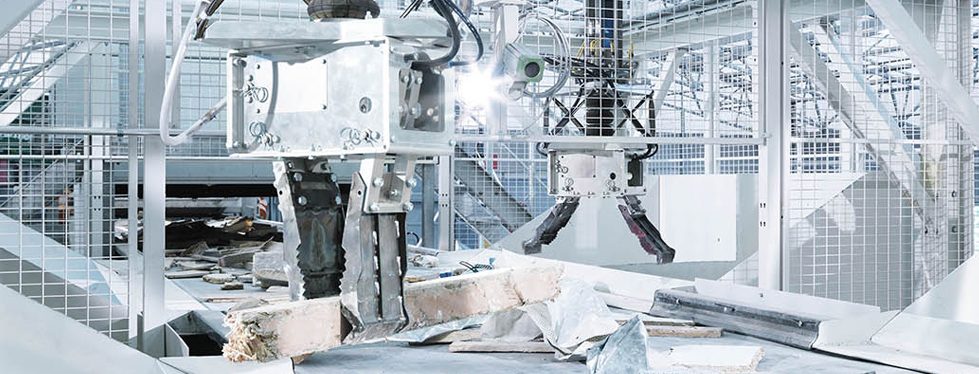
Industry 4.0, Towards The Future of Waste Treatment
Circular Economy involves a natural, evolutionary change in the waste treatment sector. To this end, new technologies and innovation will play a fundamental role in transforming the industry and each and every one of its processes.
10 of July of 2019
New technologies will play a determining role in facilitating the transformation towards a circular economy. In order to obtain secondary raw materials that can compete with virgin materials, technologies capable of boosting the current figures of material valuation will be needed, thereby facilitating the recovery of new materials that are currently in the waste flow.
Seems easy, right? It’s actually just the opposite. Waste management firms have taken advantage of an underdog mindset, founded in the existence of a series of almost insurmountable barriers that have exiled us beyond the borders of Industry 4.0.
- We’re working with the materials that the rest of the human population has thrown out, and, as such, they aren’t valued.
- Our raw materials, waste, are highly heterogeneous and of an unknown composition. How can we optimize our production process without knowing what we’re actually managing?
- The composition of waste varies across time, even throughout the same day. It’s impossible to be flexible and adapt our processes to these constant changes in quantity and quality.
- Our raw materials are dirty, moist, and release substances that create noxious odors, which complicates their selection and monitoring the process. We can’t have efficient data collection beyond manual, timely characterizations that hardly represent the flows into and out of the system. Sensorization has been virtually inexistent up until now, in part due to the difficulty of working with “complicated” flows of material.
- It is not worth the effort to try to assess more materials because the market is not demanding it. Natural resources are still abundant, and as such, they are competitive for recycled materials.
This has led us to a certain self-satisfaction, at the same time acting as a dissuasive argument against applying advanced technologies, and, as we all know, no pain, no gain.
Even if the previous arguments were partially true and truly acted as brakes or barriers against recovering materials over the last few years, they shouldn’t continue to be an obstacle preventing our activity from being led by the guiding principles of Industry 4.0. In fact, incorporating these principles must be just the trampoline we need to save all the previous barriers and transform our treatment plants into precursors and guarantors of an economy that is actually circular.
Closing the cycle: from material to waste and from waste to material
The paradigm shift marked by circular economy is no more than a logical, natural change if we consider that, hidden under the concept of waste, there are materials that were in their day either raw materials or consumer goods. That is, their status as waste is precipitated from a change in use, the human intention to case them aside, and not a change in their nature.
Waste largely consists of unused materials
So, recovering those materials present in the waste that we generate is essential to consolidating a circular economy. This task of recovery is carried out at waste selection plants, which independent of the type of waste they process – from selective pickup (containers of different colors) or trash pickup (gray container) – they are designed to fulfill two main objectives: on the one hand, maximizing the recovery of materials present in the flow of waste; on the other, ensuring proper quality of the materials recovered that enables their subsequent transformation into secondary raw materials and, as a result, gives them value.
If we look at the evolution of recovery performance reached by these “highly automated” selection plants, we will immediately realize that, after a period of growth, this positive evolution seems to have stagnated over the last few years. Current technology has hit the ceiling, and it is imperative to do something about this matter.
On the other hand, the recently updated European legislative framework continues pushing for higher and higher levels of recycling for materials, and this, in turn, pushes us toward necessary transformation for the operating processes at our waste treatment plants.
Lastly, the ever more pressing scarcity of natural resources and the emergence of the concept of circular economy has caused the markets for secondary raw materials to grow exponentially over the last few years. The market is growing, but, as is logical, it’s becoming more demanding – specialized, let’s say. A greater quantity of materials is demanded, as are higher-quality products.
Technology will be the motor of change
The latest developments and technological disciplines like computer vision, artificial intelligence, deep learning, robotics, big data, the Internet of Things, drones, augmented and virtual reality, and more have enabled the development of pilots and prototypes to test their potential application in our waste treatment facilities.
At Ferrovial Services’ Centre of Excellence for Environment, we’re carrying out a vast program of innovation projects that use new technologies in order to, on the one hand, boost the quantity and quality of the evaluated materials, and on the other, bring down barriers in the waste sector that are keeping us from being full members of the Industries 4.0 group.
The technologies being tested through different pilots at our facilities include:
- Artificial intelligence will allow us to find out the composition of our raw materials (waste) online, and to have a continual balance of masses throughout the selection process.
- RFID systems, which enable us to have greater traceability for all the materials selected, better stock and warehouse management, and in short, optimization for logistics at our facilities.
- Drones equipped with different sensors, such as vision or thermographic systems, and even incorporating artificial intelligence to improve inspection, maintenance of our activities, detecting anomalies, and the health and safety of our facilities.
- Robotics systems applied to maintenance and cleaning tasks at our selection plants, which will result in greater availability of our assets and the improvement of our treatment capacity.
- Dual systems of advanced robotics and artificial intelligence in order to improve our capacity for waste selection, obtaining a greater number of materials of higher quality and improving working conditions for and the well-being of our workers.
- Virtual reality applied to learning and simulation for maintenance, breakdowns, or as training for our staff, prior to operation.
- Augmented reality for allocating machinery, as an interface for maintenance management, and as an improvement system for self-protection and safety conditions for our workers.
- Data processing, smart software, and sensors, from providers to clients, in order to predict, control, plan, and produce intelligently, generating greater value along the entire chain.
Incorporating all of these technologies is going to enable us to develop ever more complicated tasks in less time and improve performance and safety in a sector like waste treatment, which, until now, has been outside of industry 4.0 standards.
Plants of the future: Treating waste or recovering materials?
What should the waste treatment plants of the future be like? The first thing we would change is name, to the more fitting material production plants. Secondly, we would design a plant capable of breaking through all those barriers or issues experienced at current plants. I would highlight three fundamental aspects:
- The plant of the future will be a smart plant in the sense that it will be capable of adapting to changes in the composition and quantity of materials to be treated.
- It must be a very, very safe plant. In order to do so, it will be necessary to monitor operations remotely and avoid human contact with waste. The plant of the future will be a plant where the production process stops when an access door to the area where waste is being processed is opened.
- The plant of the future must be prepared to recover 100% of the materials present in the waste flow.
In order to meet the three points outlined above, it is undoubtedly necessary for a plant to be totally connected, internally for real-time monitoring of the process, as well as externally, for water both before and after the plant itself. For before, the wastes arriving must be known beforehand, and after, the market demand for the materials and their price at all times.
The three pillars on which the plant of the future must be founded: automated, digitalized, and sensorized. Adopting and adapting them to our plants as soon as possible is the recipe for success, and it necessarily touches on incorporating technology and promoting a new operational mentality, which incorporates Industry 4.0 principles.
A real case: Artificial intelligence and robotics for automating a waste selection plant
Among the new capacities that artificial intelligence and vision have given to industrial robots are the possibility of identifying and recognizing objects in complex environments, materials with highly heterogeneous compositions and shapes, and the capacity for self-learning in relatively short time spans. This opens up a new niche for applying advanced robotics in the waste treatment sector.
To do that, we are promoting various initiatives in the field of innovation that can enable developing and adapting new robotic solutions for automating our plants. Among them, the Zenrobotics for Waste project is particularly noteworthy. With it, we intend to demonstrate that ZRR – Zenrobotics Recycler – technology, developed by the Finnish startup Zenrobotics, is a viable alternative for automating municipal waste selection plants. Its integration into the process allows us to boost current recovery figures that were not evaluated until now and improve working conditions for the staff at our facilities.
The project, which started in 2018, is being carried out at the Ecoparc4 integrated treatment plant for municipal waste in Barcelona. Since last August, the plant has had a Zenrobotics team on the selection line for voluminous waste, where material recovery was previously very low and most of those materials ended their lifecycle in the landfill. Now, thanks to the project, it’s going to be possible to recover up to eight additional materials, four for each of the two robotic arms installed.
To meet this challenge, Ferrovial Services has relied on collaboration from a European consortium that is responsible for analyzing the viability and impact of using robotics and classifying municipal waste over the project’s 22-month span. The consortium, led by Ferrovial and with co-funding from the European organization Climate-KIC, has among its partners the German research center Wuppertal Institute for Climate, Environment, and Energy, the Danish consulting firm NTU International, and the Centre for the Innovation of Smart Infrastructures.





There are no comments yet